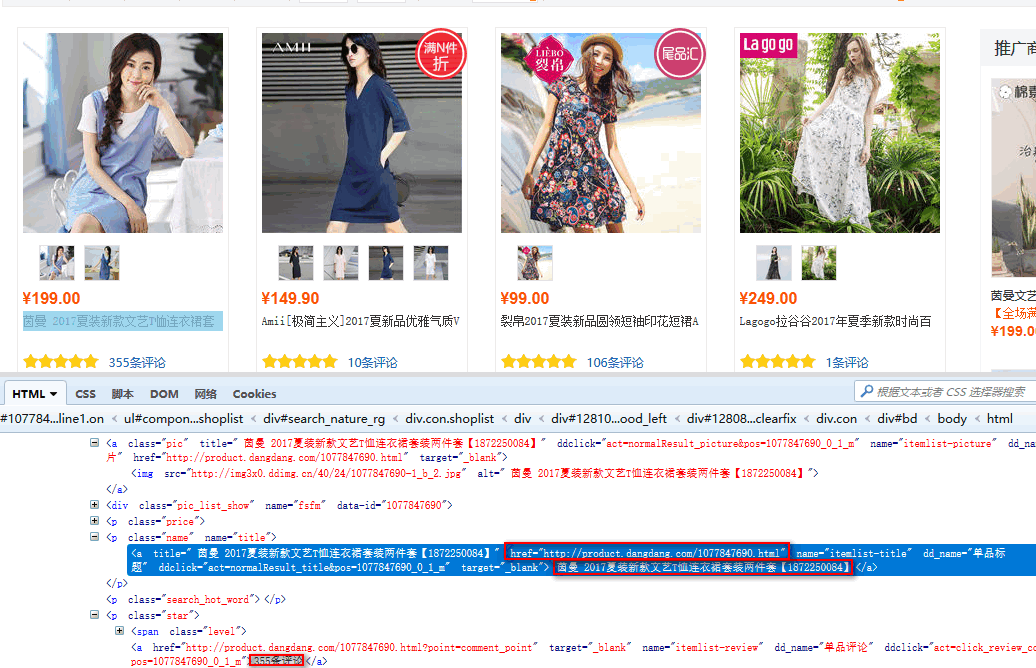第三百三十二节,web爬虫讲解2—Scrapy框架爬虫—Scrapy使用
第三百三十二节,web爬虫讲解2—Scrapy框架爬虫—Scrapy使用
xpath表达式
//x 表示向下查找n层指定标签,如://div 表示查找所有div标签
/x 表示向下查找一层指定的标签
/@x 表示查找指定属性的值,可以连缀如:@id @src
[@属性名称="属性值"]表示查找指定属性等于指定值的标签,可以连缀 ,如查找class名称等于指定名称的标签
/text() 获取标签文本类容
[x] 通过索引获取集合里的指定一个元素
1、将xpath表达式过滤出来的结果进行正则匹配,用正则取最终内容
最后.re('正则')
xpath('//div[@class="showlist"]/li//img')[0].re('alt="(\w+)')
2、在选择器规则里应用正则进行过滤
[re:正则规则]
xpath('//div[re:test(@class, "showlist")]').extract()
实战使用Scrapy获取一个电商网站的、商品标题、商品链接、和评论数

分析源码

第一步、编写items.py容器文件
我们已经知道了我们要获取的是、商品标题、商品链接、和评论数
在items.py创建容器接收爬虫获取到的数据
设置爬虫获取到的信息容器类,必须继承scrapy.Item类
scrapy.Field()方法,定义变量用scrapy.Field()方法接收爬虫指定字段的信息
# -*- coding: utf-8 -*- # Define here the models for your scraped items # # See documentation in: # http://doc.scrapy.org/en/latest/topics/items.html import scrapy #items.py,文件是专门用于,接收爬虫获取到的数据信息的,就相当于是容器文件 class AdcItem(scrapy.Item): #设置爬虫获取到的信息容器类 # define the fields for your item here like: # name = scrapy.Field() title = scrapy.Field() #接收爬虫获取到的title信息 link = scrapy.Field() #接收爬虫获取到的连接信息 comment = scrapy.Field() #接收爬虫获取到的商品评论数
第二步、编写pach.py爬虫文件
定义爬虫类,必须继承scrapy.Spider
name设置爬虫名称
allowed_domains设置爬取域名
start_urls设置爬取网址
parse(response)爬虫回调函数,接收response,response里是获取到的html数据对象
xpath()过滤器,参数是xpath表达式
extract()获取html数据对象里的数据
yield item 接收了数据的容器对象,返回给pipelies.py
# -*- coding: utf-8 -*- import scrapy from adc.items import AdcItem #导入items.py里的AdcItem类,容器类 class PachSpider(scrapy.Spider): #定义爬虫类,必须继承scrapy.Spider name = 'pach' #设置爬虫名称 allowed_domains = ['search.dangdang.com'] #爬取域名 start_urls = ['http://category.dangdang.com/pg1-cid4008149.html'] #爬取网址 def parse(self, response): #parse回调函数 item = AdcItem() #实例化容器对象 item['title'] = response.xpath('//p[@class="name"]/a/text()').extract() #表达式过滤获取到数据赋值给,容器类里的title变量 # print(rqi['title']) item['link'] = response.xpath('//p[@class="name"]/a/@href').extract() #表达式过滤获取到数据赋值给,容器类里的link变量 # print(rqi['link']) item['comment'] = response.xpath('//p[@class="star"]//a/text()').extract() #表达式过滤获取到数据赋值给,容器类里的comment变量 # print(rqi['comment']) yield item #接收了数据的容器对象,返回给pipelies.py
robots协议
注意:如果获取的网站在robots.txt文件里设置了,禁止爬虫爬取协议,那么将无法爬取,因为scrapy默认是遵守这个robots这个国际协议的,如果想不遵守这个协议,需要在settings.py设置
到settings.py文件里找到ROBOTSTXT_OBEY变量,这个变量等于False不遵守robots协议,等于True遵守robots协议
# Obey robots.txt rules ROBOTSTXT_OBEY = False #不遵循robots协议
第三步、编写pipelines.py数据处理文件
如果需要pipelines.py里的数据处理类能工作,需在settings.py设置文件里的ITEM_PIPELINES变量里注册数据处理类
# Configure item pipelines # See http://scrapy.readthedocs.org/en/latest/topics/item-pipeline.html ITEM_PIPELINES = { 'adc.pipelines.AdcPipeline': 300, #注册adc.pipelines.AdcPipeline类,后面一个数字参数表示执行等级,数值越大越先执行 }
注册后pipelines.py里的数据处理类就能工作
定义数据处理类,必须继承object
process_item(item)为数据处理函数,接收一个item,item里就是爬虫最后yield item 来的数据对象
# -*- coding: utf-8 -*- # Define your item pipelines here # # Don't forget to add your pipeline to the ITEM_PIPELINES setting # See: http://doc.scrapy.org/en/latest/topics/item-pipeline.html class AdcPipeline(object): #定义数据处理类,必须继承object def process_item(self, item, spider): #process_item(item)为数据处理函数,接收一个item,item里就是爬虫最后yield item 来的数据对象 for i in range(0,len(item['title'])): #可以通过item['容器名称']来获取对应的数据列表 title = item['title'][i] print(title) link = item['link'][i] print(link) comment = item['comment'][i] print(comment) return item
最后执行
执行爬虫文件,scrapy crawl pach --nolog

可以看到我们需要的数据已经拿到了




【推荐】编程新体验,更懂你的AI,立即体验豆包MarsCode编程助手
【推荐】凌霞软件回馈社区,博客园 & 1Panel & Halo 联合会员上线
【推荐】抖音旗下AI助手豆包,你的智能百科全书,全免费不限次数
【推荐】轻量又高性能的 SSH 工具 IShell:AI 加持,快人一步